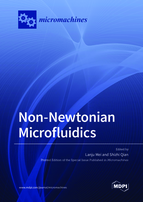Non-Newtonian Microfluidics
A special issue of Micromachines (ISSN 2072-666X). This special issue belongs to the section "E:Engineering and Technology".
Deadline for manuscript submissions: closed (31 January 2022) | Viewed by 33712
Special Issue Editors
Interests: micro/nanofluidic electrokinetics; viscoelastic fluids; micromixing; MEMS sensors
Special Issues, Collections and Topics in MDPI journals
Interests: micro/nanofluidics; non-Newtonian fluidics; transport phenomena in micro and nanoscales
Special Issues, Collections and Topics in MDPI journals
Special Issue Information
Dear Colleagues,
Microfluidics has seen a remarkable growth over the past decades, with its extensive applications in engineering, medicine, biology, chemistry, etc. Many of these real applications of microfluidics involve the handling of complex fluids such as whole blood, protein solutions, and polymeric solutions which exhibit non-Newtonian characteristics—specifically viscoelasticity. The elasticity of the non-Newtonian fluids induces intriguing phenomena such as elastic instability and turbulence even at extremely low Reynolds numbers. This is the consequence of the nonlinear nature of the rheological constitutive equations. The nonlinear characteristic of non-Newtonian fluids can dramatically change the flow dynamics, and is useful to enhance mixing at the microscale. Electrokinetics in the context of non-Newtonian fluids are also of significant importance, with their potential applications in micromixing enhancement and bio-particles manipulation and separation. In this Special Issue, we welcome research papers, and review articles related to the applications, fundamentals, design, and the underlying mechanisms of non-Newtonian microfluidics, including discussions, analytical papers, and numerical and/or experimental analyses.
Dr. Lanju Mei
Prof. Dr. Shizhi Qian
Guest Editors
Manuscript Submission Information
Manuscripts should be submitted online at www.mdpi.com by registering and logging in to this website. Once you are registered, click here to go to the submission form. Manuscripts can be submitted until the deadline. All submissions that pass pre-check are peer-reviewed. Accepted papers will be published continuously in the journal (as soon as accepted) and will be listed together on the special issue website. Research articles, review articles as well as short communications are invited. For planned papers, a title and short abstract (about 100 words) can be sent to the Editorial Office for announcement on this website.
Submitted manuscripts should not have been published previously, nor be under consideration for publication elsewhere (except conference proceedings papers). All manuscripts are thoroughly refereed through a single-blind peer-review process. A guide for authors and other relevant information for submission of manuscripts is available on the Instructions for Authors page. Micromachines is an international peer-reviewed open access monthly journal published by MDPI.
Please visit the Instructions for Authors page before submitting a manuscript. The Article Processing Charge (APC) for publication in this open access journal is 2600 CHF (Swiss Francs). Submitted papers should be well formatted and use good English. Authors may use MDPI's English editing service prior to publication or during author revisions.
Keywords
- microfluidics
- non-Newtonian fluids
- rheology
- elasticity
- nonlinearity
- constitutive equations
- micromixing enhancement
- elastic instability
- turbulence
- electrokinetics
- bio-particle manipulation
- design
- underlying mechanism








